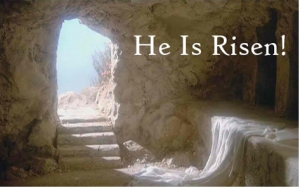Make no mistake: if He rose at all
it was as His body;
if the cells’ dissolution did not reverse, the molecules
reknit, the amino acids rekindle,
the Church will fall.
It was not as the flowers,
each soft Spring recurrent;
it was not as His Spirit in the mouths and fuddled
eyes of the eleven apostles;
it was as His flesh: ours.
The same hinged thumbs and toes,
the same valved heart
that–pierced–died, withered, paused, and then
regathered out of enduring Might
new strength to enclose.
Let us not mock God with metaphor,
analogy, sidestepping, transcendence;
making of the event a parable, a sign painted in the
faded credulity of earlier ages:
let us walk through the door.
– Seven Stanzas at Easter (excerpt), John Updike[1]
Dear Easter People,
Christ is risen, Alleluia! I often experience a “spring” in my step when walking on this side of Easter. Though our journey from a Lenten to an Easter sensibility may proceed more slowly due to the pandemic that still holds sway over much of the world, we are, nonetheless, called to live as Easter people; called to embody resurrection hope in our lives, and put it on display in tangible ways. After all, Easter is not a single day on the calendar—or even a season—it is a way of life!
In a recent article, Peter Marty tells how his maternal grandmother died suddenly at age 40, leaving behind a bereaved husband and an eight-year-old daughter (Peter’s mother.) His grandfather, a Lutheran pastor, struggled to move beyond the grief that crippled him. Every Sunday afternoon for years, he would make his daughter accompany him to the cemetery to visit the grave. “This weekly ritual,” Marty writes, “cast such a pall over my mother’s young life that it essentially blocked every other memory of her childhood.” He goes on: “Something in me wishes that a gravedigger would have walked up to him one Sunday at Cave Hill, interrupted his mourning, and said straight to his face, ‘You know, you really need to go and do something else with your Sundays. Good years are still ahead of you and your daughter. Go and make something of your life that’s not going to happen here. I’ll take care of the grave.’”[2]
Once, in the crypt at Christchurch Cathedral in Dublin (where post-worship coffee hour is held!), I saw something fascinating—if a bit bizarre: The mummified remains of a cat and a rat encased in glass. The sign told how the cat, (presumably chasing the rat), became stuck with its prey in a Cathedral organ pipe 150 years ago. As a result, both were mummified. The moral of the story? Those places we become stuck in life will become our graves if we’re not careful.
The fears, regrets, and failures that cling so closely to us can make forward movement seem impossible, locking us in a perpetual struggle from which we cannot extricate ourselves; leading us to doubt God’s presence or even existence.
All of these elements were present in the graveyard Peter Marty’s mother and grandfather visited weekly—and they were present, too, in the graveyard outside of Jerusalem where the women went to tend the body of their crucified Lord. But on this trip to the graveyard, something new, something unpredictable took place—the stone was rolled away; the tomb was empty. Jesus had been raised. Later that night, St. John tells us, the resurrected Christ made his first appearance to his fearful community, showing them his wounded hands and side and blessing them with peace. But even after that physical and spiritual encounter, the adjustment of Jesus’ apprentices to the new Easter reality didn’t happen overnight. It took years before Jesus’ disciples could put into words what they experienced and what it meant.
What does this mean for us? It means we have time. Time to discern specifically how the resurrected Christ might manifest himself in our individual lives and in the life of our community. Time to put our faith into practice on a daily basis, reaching beyond the fear, the loss, and the uncertainty that perpetually seeks to hold us captive.
No imagined resurrection can set us free from fears that crouch so closely, so craftily in the midst of our lives; no metaphorical resurrection can get us unstuck from the pervasive struggles that come with the territory of being human—only a bodily one can. “Make no mistake,” writes Updike, “if He rose at all, it was as His body…” Only the resurrection could turn cowardly Peter into a powerful preacher; could transform the persecutor Saul into the missionary Paul. Only the resurrection could turn ordinary women and men into saints and martyrs, preachers and prophets, activists and organizers intent on building bridges rather than walls, and in the process rising from the margins to become a living, breathing, vibrant community with people of every tribe and race, tongue and nation.[3]
As this Easter season enfolds we’ll be tracking both the growing percentage of vaccinations given and the proliferation of new virus strains. We’ll be developing scenarios for what a return to in-person worship might look like. We’ll be adjusting to children returning to school in hybrid models and bracing ourselves for how this return will affect our household schedules. As we engage these matters, let’s do so with a commitment to not getting stuck; let’s do so with a spirit of hopeful expectation. For Christ is risen indeed! Alleluia!
Pastor Erik
[1] John Updike, “Seven Stanzas at Easter,” from Telephone Poles and Other Poems. New York: Alfred A. Knopf, 1959. Published in Bread and Wine: Readings for Lent and Easter. Maryknoll, NY: Orbis, 2003, p. 261.
[2] Peter Marty, Christian Century. Find his full article here: https://www.christiancentury.org/article/living-word/april-4-easter-day-b-mark-161-8
[3] Shawnthea Monroe, The Word , March 16, 2016 edition of Christian Century.





